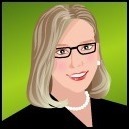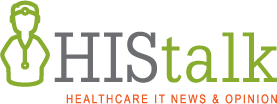Traditionally Professional Courtesy is something that physicians gave each other - but we had to be careful with it when…
Curbside Consult with Dr. Jayne 4/14/25
Mr. H currently has a poll in the field, courtesy of this week’s Monday Morning Update, that asks, “What’s your biggest red flag when evaluating a health IT vendor?”
Of the listed response options, my top two include “Leadership team is all career investors or executives” followed by “Lists no real customers, just pilots.” By way of additional suggestions, I would add “Leadership team has no idea what the average person experiences when they have a health-related need.” This answer was brought into the spotlight for me this week, as I had the opportunity to interact with a large number of ladies at a senior women’s seminar.
I normally try to downplay the fact that I’m a physician when I meet people I don’t know, because I don’t want to field the resulting clinical questions. However, in this situation I was a presenter and the person doing my introduction mentioned it, so I couldn’t escape it.
Once that proverbial cat was out of the bag, I heard a lot of healthcare stories, ranging from heartbreaking to inspiring, and a couple that spawned ideas for innovation. For those of you who don’t have a lot of real-world healthcare experience but are operating in this space, I give you my guide to understanding what a random sampling of what people want to talk about concerning healthcare when given the chance.
At the first meal break, I was asked where I practice. I explained about being a virtual physician, thinking that my tablemates might not be familiar with it. The first person that spoke wanted to know, “What do you think about the fact that Medicare is going to stop paying for online doctor visits, because I’m pretty mad about it.” Talk about a softball being dropped right in my lap.
She went on to explain that in her Arizona community, many of the residents are elderly, some no longer drive, and certain specialty care is a 2.5 hour drive away. She and her husband have been having virtual visits for the last several years, only going in person once a year or when a specialized test is needed. They are able to have labs drawn at a satellite draw site for one of the nationwide lab vendors. She has been able to avoid long hours on the highway as well as the hassle of getting her mobility-impaired spouse into the car.
The conversation segued from there to the need for non-traditional home services. Another mentioned the fact that her local emergency medical services agency’s funding shortfall led them to start charging for any calls that don’t result in transportation to the emergency department.
She was worried about a couple of things. First, people may not call for help when they need it, resulting in them “winding up sicker than they need to be.” Second, there’s a gap in providing services that are important but non-emergency. The example she gave was when someone falls and needs help to get up, but doesn’t need to go to the emergency department. This happened to one of her neighbors who called her, and when the weren’t able to find a younger neighbor to help, they ended up calling 911.
This immediately gave me an entrepreneurial idea — like a ride share service, but for things like this. I did a quick online search and most of the answers to “how to safely pick a loved one up after a fall” involved calling 911 or the fire department for a “lift assist,” which may or may not have an associated charge. What if there was an app where you could summon an available person who is not only physically capable of providing this kind of assistance, but has also has had their background checked and vetted by a third party so that seniors would be more comfortable calling them?
I’m seeing an opportunity for off-duty healthcare workers to make some cash in a way that they’re comfortable with, but that requires no charting and has few hassles. Kind of like TaskRabbit but with a personal assistance twist and with rapid access.
Maybe it could also have a “schedule in advance” component for non-urgent calls, again kind of like a ride share service, when you don’t need to move a person but just need to move that box of cast iron skillets so you don’t break your foot (which also happened to one of the ladies at my table who was in a walking boot). There may be some variations of this out there, but none that I’m aware of has the breadth of availability that would be ideal for a growing population of aging seniors.
From there, the conversation flowed to the predictable topics, including physicians who always run behind, long waits for new patient appointments, the hassles of dealing with insurers, expensive medical bills, and whether or not I watch medical TV shows. Nearly everyone at the table had used a patient portal to communicate with a physician at least once, and about half of those have received text messages from medical providers. All of them had smartphones and didn’t hesitate to pass around pictures of the grandkids, the great grands, or their various craft projects.
They were universally comfortable with using the internet to find information, whether it was for a health-related topic or just to find out general information. It was validating to see this in person since I run into a lot of people who still think that seniors aren’t technology savvy.
My dinner table assignment had several retired healthcare workers who each had something to say about the current state of things. A correctional health nurse midwife said that the greatest need is for better behavioral health services and supports “to keep people out of prison in the first place.” A retired physical therapist from a VA hospital was extremely vocal about the need to make sure that our veterans are taken care of and that any cuts at the VA should be done thoughtfully and “not in some all-fired hurry.” Another was a nurse who medically retired sooner than she would have liked. She was most excited to learn about virtual nursing opportunities, which might have allowed her to stay in the field longer.
All of them had EHR experience and thought things were better in some ways and worse in others when EHRs came to their facilities, which many of us agree is a fairly accurate statement. All three had children or grandchildren who were in the medical field, so that gave me a little bit of hope as far as healthcare still being a desirable career choice.
Vaccines were a hot topic among those who weren’t healthcare retirees. One of my dining companions told the story of when she received one of the first polio vaccines and “people were lined up around the block because it was a horrible disease and there wasn’t a single mother who didn’t want her children to take that sugar cube.” She was an amazing dinner companion, a retired university professor who has traveled the world and had stories that made me hope I’ll still be globetrotting into my eighties as she is. She ended up accepting my LinkedIn request about an hour after I sent it, which impressed me. She doesn’t have any content associated with her profile, which adds to her mystique, I guess. No need for self-promotion in that generation.
At the end of the meal, there was a raffle with proceeds going to a family that has three children with medically complex needs. Hearing the raffle chair tell their stories was incredibly moving. I can’t imagine navigating the healthcare system with one of their situations, let alone with three. It was gratifying to see several thousand dollars raised to support them.
These are things that average people in the US want to talk about when they find out that you’re in healthcare. If you’re a healthcare technology leader and none of these resonate with you, it might be time to obtain some experiential learning through hanging out with people who consume a fair amount of healthcare resources. It might confirm your thinking, give you new ideas, or give you something to think about that you haven’t considered. If nothing else, it should remind you that there are humans on the other end of your solution, whether they’re patients, family members, care delivery team members, or those who support them. And as leaders, if you don’t have a clear line of sight to those people and understand how your solution impacts them, you might just have some work to do.
What kinds of things do you hear when people find out you’re “in healthcare?” Leave a comment or email me.

Email Dr. Jayne.


Dr Jayne–where was that seniors seminar? Sounds like we could turn it into a fabulous focus group for every digital health company out there!!
Oh trust me, as focus group participants they’d give companies an earful!